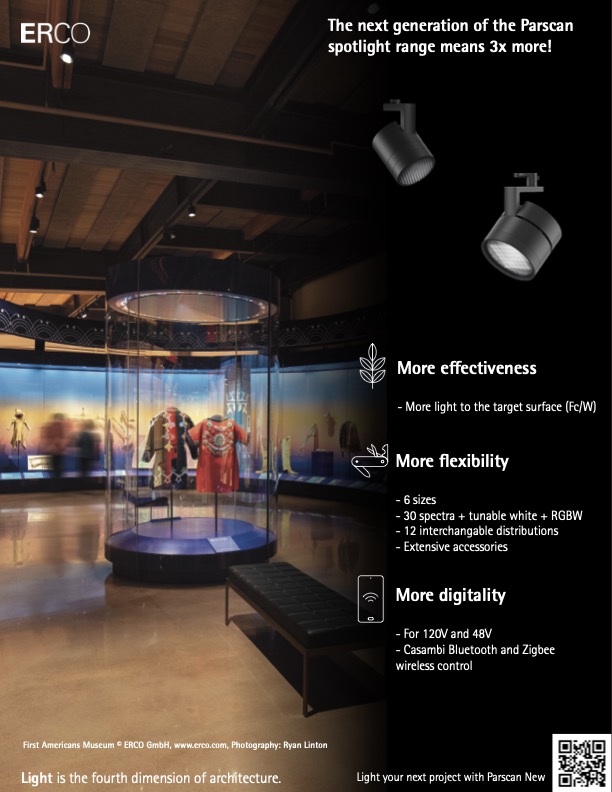
7 minute read
Digitizing Lighting in the Era of Decarbonization
By CAROL JONES
DALI Alliance, NA Market Development Manager
Photo Credit: Ilker - stock.adobe.com
Webster defines an era as "a period identified by some prominent figure or characteristic feature," and "a stage in development." Reflecting on my years in lighting, it wasn't hard to identify distinct developmental stages. In some cases, we can be proud of our participation as an industry. We have been leaders in energy efficiency, lighting quality, and healthy buildings. Sustainability and circularity are an ongoing effort. On the other hand, our presence and leadership have been lacking in the net zero, resilience, and decarbonization movements.
It begs the question—why? In this author’s humble opinion, it’s because these challenges in particular require digital, addressable and granular lighting controls features. There has been awareness, buzz, and a sliver of good examples—but if we are honest with ourselves, we can't say we've made major progress. North America is a 0-10V analog region.
To be fair, there are legitimate reasons why we haven't transitioned to interoperable digital controls. There are profound barriers integral to sales channel dynamics, including financial disincentives, as well as educational gaps throughout the lighting ecosystem.
I recently went to several conferences to learn about the relevance of digital lighting in the decarbonization era. My findings were consistent and troubling. At this year's CREtech in NYC, decarbonization was THE topic. Most attendees were real estate professionals, with a decent number of trade vendors, practitioners and domain experts represented. I spoke with many highlevel real estate executives and contractors from large global firms, including Brookfield Properties, Vornado Realty Trust, The Durst Organization, GSA, Tishman Speyer, JLL, Johnson Controls, Schneider Electric, and more. I couldn’t resist calculating the square footage of the real estate owners and operators that I spoke with: >5.6 billion square feet. The Greenbuild conference was similar, and upcoming conferences are also prioritizing the topic of decarbonization.
The takeaway from my short interviews and conversations is: "We are done with lighting." The sentiment was echoed by an onstage reply to a question from the audience, "What is the first thing we should do towards decarbonization—what is the low-hanging fruit?"
Answer: "The first thing that comes to mind is lighting, but we have already converted to LEDs. There could be controls, but all the vendors talk about is what makes them different and better than the next guy, and we can't figure it out." Then he moved on to heat pumps and other technologies.
These people are not ideologues. They are sophisticated real estate leaders. According to Schneider Electric, 90% of existing buildings will become a financial risk if they fail to decarbonize. Importantly, the ROI for medium-level decarbonization efforts is expected to be in the range of 8-15 years, which could make a significant difference in the viability of controls retrofits.
In a conversation with Lance Davis, FAIA, LEED Fellow, GSA, Sustainability Architect and P100 Manager, he said, "GSA has the largest managed inventory in the country, totaling 366 million SF of owned and leased property. Most of our buildings are long-term assets, so we need to be concerned about what happens 5, 10, 30 years from now. If a driver or sensor is discontinued or a manufacturer goes under, will we be stuck without the data that we use for real-time operations?" Clearly, digital, interoperable technology is the best way for GSA to be good stewards of our government buildings.
Real-time operation has taken on a new meaning now that commercialization of AI and machine learning for buildings is underway. Gary Chance, CEO of the award-winning and industry-leading company Prescriptive Data, creator of Nantum OS, offers an important sentiment: "Breaking down the silos of digital data within buildings is the cornerstone of operational decarbonization. Once data has been collected, cleaned, and properly stored, it can be applied to additional machine learning algorithms that help detect patterns and anomalies, creating economic opportunities for real estate owners. We don't work with lighting as often as we would like, but we see tremendous value in integrating lighting automation with other buildings systems.”
"We are done with lighting."

It helps to clarify the priority criteria for customer success. Building owners and managers want a global open protocol that enables interoperability between sensors and drivers and delivers data in a standardized format to support APIs and integration with multiple controls and buildings systems.
Michael Amato, a Systems Sales Specialist at Signify and formerly an integrator at FSG, says: "Digital solutions and system integration is the future, and end-users want interoperability and smooth operations for the long-term. Meeting their needs builds trust, expands markets, and allows our innovations to deliver their full value. Isn't it time for the lighting industry at large to make this a priority?"
The global DALI Alliance delivers on these requirements. DALI-2 is now capable of providing data about luminaires, energy measurement, color control, fault diagnostics, and emergency. Most recently, the release of the D4i specification now extends to wireless technology and supports integral sensors and controllers when paired with the Zhaga Book 20 standard. Critically important, interoperability is verified through testing and certification. Efforts are ongoing to enable functionality with multiple wireless communication protocols including Bluetooth mesh, Zigbee and Thread.
The elephant in the room is us, and it's a lonely place to be. We do not have a seat at the decarbonization table. Our ongoing competition between proprietary controls technologies has made us irrelevant in the eyes of most decision-makers. I submit that our focus should be on industry alignment to expand opportunities overall, rather than competing with each other using an offering that is compromised in the eyes of the decision makers. Huge money is being invested into decarbonizing buildings, and as it stands, we will not get a meaningful slice of that pie.
Putting aside the most well-known integration use cases (e.g., realtime feedback from sensors to room reservation systems and HVAC systems), there are a multitude of new market drivers. For example, the highly nuanced dimming of individual luminaires in consideration of their room type and occupant needs enables maximum load shedding at peak hours. Digital interaction with Grid-interactive Efficient Buildings helps to manage electrification including integration of renewable energy and batteries. Monitoring lighting energy consumption in real-time helps owners to report progress and compliance with the rapid proliferation of Building Performance Standards (BPS) such as Local Law 97 in New York City, where the consequence of non-compliance with carbon reduction requirements will be heavy fines. LL97 has received the most visibility, but according to the National BPS Coalition, there are 40 municipalities that have adopted similar requirements.
So how do we make this happen? Spec it. Defend it. Learn, and teach. For many years I've heard our specification community pleading for interoperability and reliability. Avraham Mor, CLD, IALD, says it well: "The world is going digital all around us with every kind of technology imaginable, yet the industry is still defaulting to 0-10V dimming. It's way past time for the lighting industry to make the shift to digital, addressable, and interoperable controls technology. Designers have the responsibility to commit to the learning curve and advocate for this in our specs. Morlights can't do it alone, but we can be part of the solution."
The next era? Considering decarbonization is mission critical to mitigating the climate change crisis, it's difficult to imagine the next era. Whatever it is, I can guarantee that digital and interoperable technology will be central to success.











